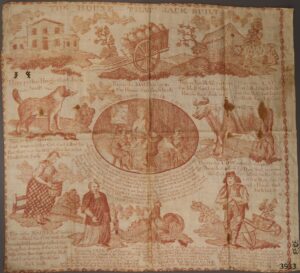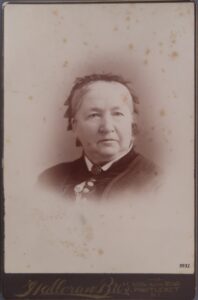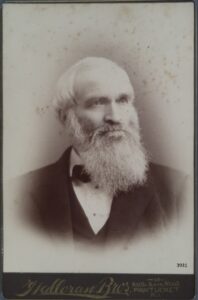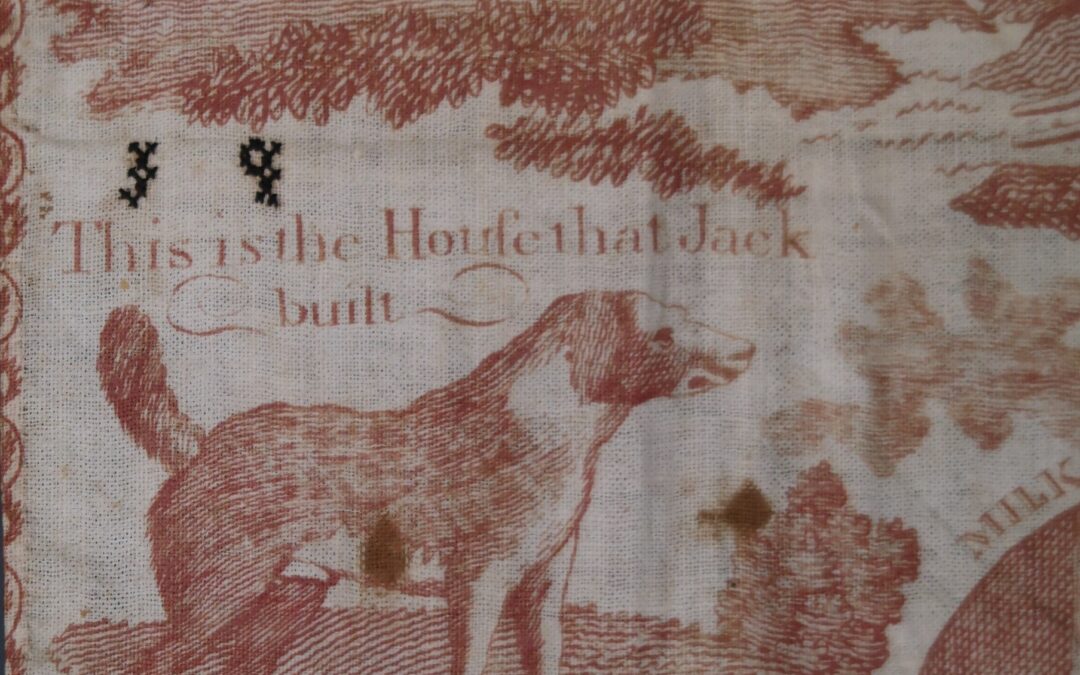The Sutter’s Fort Curatorial Department is celebrating International Children’s Book Day by drawing your attention to a decorative handkerchief donated to Sutter’s Fort by Harriet Hoyt in 1932. The handkerchief is printed with text and illustrations in red on a linen cloth, depicting the old English nursery rhyme, The House That Jack Built. Near the top left corner, just over the first line of the poem two letters are embroidered: a J and a backwards P. Through this unique marking our team was able to connect this object to John Perry, a man whose life story exemplified the new beginnings that California offered to many settlers in the 19th century.
John Perry was born in Rhode Island and married Eliza Mann in 1845. The two lived in the textile mill that employed John as a packer. But hard work and meager living allowed the couple to seize opportunity when it came. Arriving in California in the mid-1850s, John came as a merchant, not a miner. In 1856 the Sperry and Perry Hotel in the town of Murphys opened as an operation co-owned by James Sperry and John Perry. Though the building has taken a few physical forms and bared a few different names, it still operates today in the town of Murphys as the Mitchler Hotel, one of the oldest active hotels in the state.
Soon after the success of the Sperry and Perry Hotel, the economic partnership invested in a similar venture just up the road in the mountains. This was the Calaveras Big Trees Hotel, a hotel famous in its day for hosting dances on a single massive tree stump, and in the vicinity of Calaveras Big Trees State Park today. This was John Perry’s final business venture. In 1874 he passed away in the Big Trees grove where he lived. His remains were returned to Rhode Island to rest near his mother while his businesses were kept very much alive by his widow, Eliza.
How did Perry’s handkerchief become part of the Sutter’s Fort collection? Through Eliza’s second husband Nathanial Hoyt. Hoyt was a ‘49er who came to California from New Hampshire. For nearly twenty years he worked as a miner in the calaveras county area. Nathaniel Hoyt and Eliza Mann Perry (now Hoyt) married in San Francisco in 1882, she for the second time at age sixty-one, and he for the first time at sixty-five, the same age her late husband would have been.
Eliza held onto a few tokens of her first love including his childhood handkerchief. And those most meaningful, like this handkerchief, she passed on to her second husband when she died in 1896. In time Nathaniel would pass these mementos to his sister, and her to his niece, Harriet, who may very well have never heard the name John Perry. Harriet, in turn, donated a plethora of family items to the Sutter’s Fort collection in 1933. Yet because of the initials and research done by our team, we can attribute this object to John Perry. The only other item in the collection bearing the same mark is a small pocketknife donated by Harriet Hoyt and given to her by her Uncle Nat (Nathaniel).
Through research, objects have new beginnings as hidden connections are revealed.



About the Sutter’s Fort Collection
In addition to the historic structures at Sutter’s Fort SHP, Friends of Sutter’s Fort also is committed the preservation of the many artifacts that are part of the Sutter’s Fort Collection. This expansive collection of artifacts is housed both at Sutter’s Fort, and at the State Museums Collections Center, which is also managed by California State Parks.

